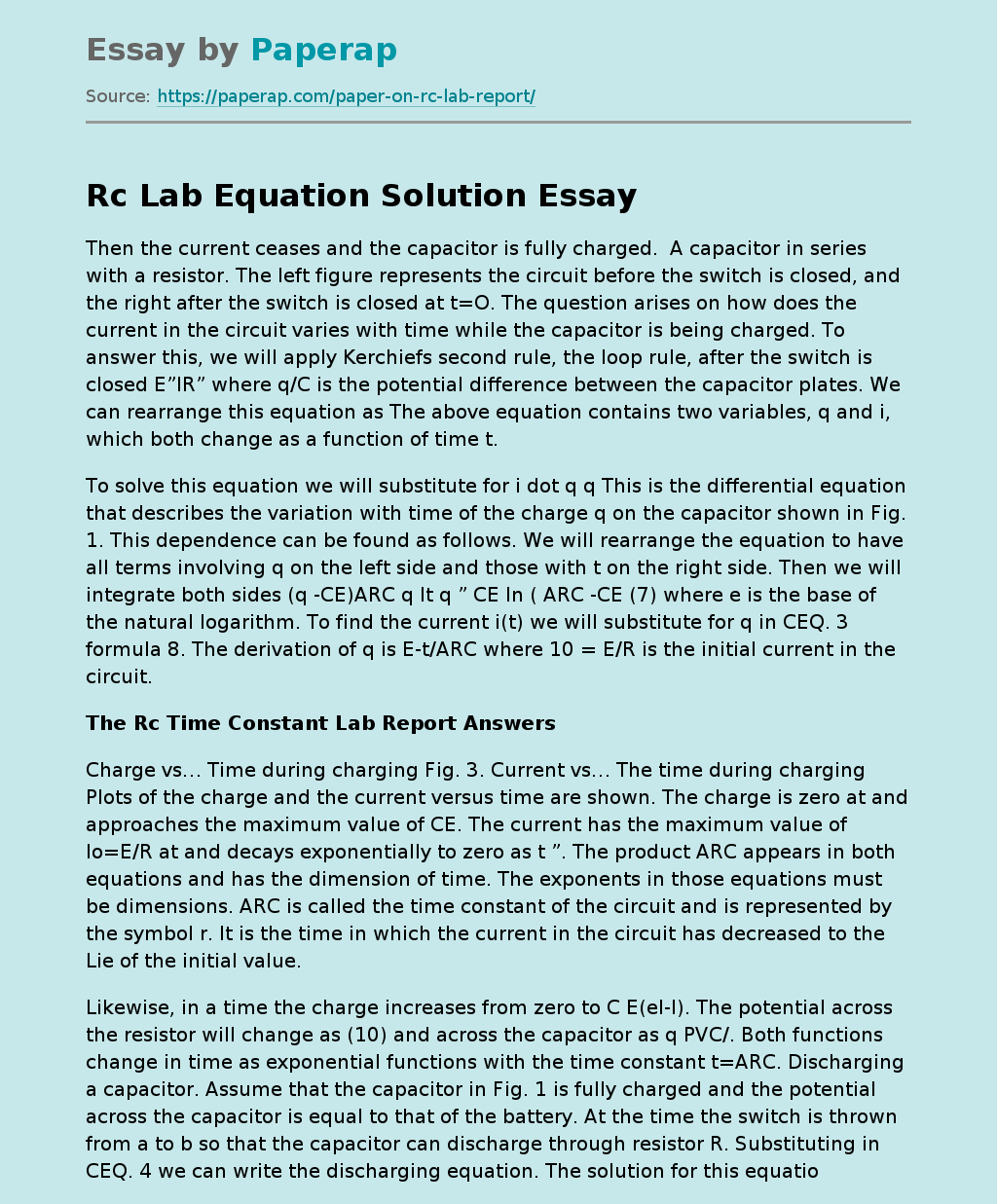Rc Lab Equation Solution
Then the current ceases and the capacitor is fully charged. A capacitor in series with a resistor. The left figure represents the circuit before the switch is closed, and the right after the switch is closed at t=O. The question arises on how does the current in the circuit varies with time while the capacitor is being charged. To answer this, we will apply Kerchiefs second rule, the loop rule, after the switch is closed E”IR” where q/C is the potential difference between the capacitor plates.
We can rearrange this equation as The above equation contains two variables, q and i, which both change as a function of time t.
To solve this equation we will substitute for i dot q q This is the differential equation that describes the variation with time of the charge q on the capacitor shown in Fig. 1. This dependence can be found as follows. We will rearrange the equation to have all terms involving q on the left side and those with t on the right side.
Then we will integrate both sides (q -CE)ARC q It q ” CE In ( ARC -CE (7) where e is the base of the natural logarithm. To find the current i(t) we will substitute for q in CEQ. 3 formula 8. The derivation of q is E-t/ARC where 10 = E/R is the initial current in the circuit.
The Rc Time Constant Lab Report Answers
Charge vs… Time during charging Fig. 3. Current vs… The time during charging Plots of the charge and the current versus time are shown.
The charge is zero at and approaches the maximum value of CE. The current has the maximum value of lo=E/R at and decays exponentially to zero as t ”. The product ARC appears in both equations and has the dimension of time. The exponents in those equations must be dimensions. ARC is called the time constant of the circuit and is represented by the symbol r. It is the time in which the current in the circuit has decreased to the Lie of the initial value.
Likewise, in a time the charge increases from zero to C E(el-l). The potential across the resistor will change as (10) and across the capacitor as q PVC/. Both functions change in time as exponential functions with the time constant t=ARC. Discharging a capacitor. Assume that the capacitor in Fig. 1 is fully charged and the potential across the capacitor is equal to that of the battery. At the time the switch is thrown from a to b so that the capacitor can discharge through resistor R. Substituting in CEQ. 4 we can write the discharging equation. The solution for this equation is = Joe
The current can be obtained by differentiating CEQ. 3 i(t)= = ” ole (14) The minus sign indicates that the direction of the discharge current is in the direction opposite to the charging current. Both functions, q(t) and i(t), decay exponentially with the same time constant = ARC. The potential IVR across the resistor is given by and the potential across the capacitor, PVC, changes in time as ) ” TTL PVC(t)- (16) Resistor-capacitor network 2. Procedure The time constant t may be determined experimentally either during charging or discharging of the capacitors. You will use the R-C network shown in Fig. The switches allow you to select different combinations of resistors and capacitors. The positions of the switches shown in Fig. 4 result in the ARC circuit with. Ox Q and C=O. XX-6 F, compare Fig. 5. Fig. 5. ARC circuit corresponding to the positions of the switches in Fig. 4. To charge the capacitor you will use a DC Power Supply, Paso model 9049. Select the 30 V range. The R-C network is designed to work only within this range. The “VARIABLE” control turns the power supply on and varies the voltage from O to IV. The output voltage can be read on the bottom scale of the meter.
The output terminals have different colors, black for the negative terminal and red for the positive. The green terminal is only for 500 and 1000 V ranges – do not use it!! Charging a capacitor. Set the circuit as shown. Select a resistor R and a capacitor C. Attached is the electrocuted to measure the voltage across the capacitor. Close the switch and start the timer. At regular time intervals record the capacitor voltage. Experimental setup to charge a capacitor. Discharging a capacitor. Charge the capacitor to the initial potential of 30 VIDE. Disconnect the power supply and close the circuit by sliding the switch to the bottom position.
Simultaneously start the timer. Use the electrocuted to measure the voltage across the capacitor at the same time intervals. Repeat point for other values of R and C. Repeat the experiment by charging and discharging capacitors as in and but this time measure the voltage across the resistor. According to Ohm’s law, the potential is proportional to resistance multiplied by current. Hence, the potential across the resistor is proportional to the charging current. Report Plot logarithm of the capacitor voltage during charging versus time for different ambitions of R and C.
Rc Lab Equation Solution. (2019, Dec 05). Retrieved from https://paperap.com/paper-on-rc-lab-report/

